
Plantago is a genus of about 200 species of flowering plants in the family Plantaginaceae, commonly called plantains or fleaworts. The common name plantain is shared with the unrelated cooking plantain. Most are herbaceous plants, though a few are subshrubs growing to 60 centimetres tall.

Psyllium, or ispaghula, is the common name used for several members of the plant genus Plantago whose seeds are used commercially for the production of mucilage. Psyllium is mainly used as a dietary fiber to relieve symptoms of both constipation and mild diarrhea, and occasionally as a food thickener. Allergy to psyllium is common in workers frequently exposed to the substance.

Alisma plantago-aquatica, also known as European water-plantain, common water-plantain or mad-dog weed, is a perennial flowering aquatic plant widespread across most of Europe and Asia, and apparently spread elsewhere in both the Old and New World.

Alisma is a genus of flowering plants in the family Alismataceae, members of which are commonly known as water-plantains. The genus consists of aquatic plants with leaves either floating or submerged, found in a variety of still water habitats around the world. The flowers are hermaphrodite, and are arranged in panicles, racemes, or umbels. Alisma flowers have six stamens, numerous free carpels in a single whorl, each with 1 ovule, and subventral styles. The fruit is an achene with a short beak.

Plantago lanceolata is a species of flowering plant in the plantain family Plantaginaceae. It is known by the common names ribwort plantain, narrowleaf plantain, English plantain, ribleaf, lamb's tongue, and buckhorn. It is a common weed on cultivated or disturbed land.

Plantago major, the broadleaf plantain, white man's footprint, waybread, or greater plantain, is a species of flowering plant in the plantain family Plantaginaceae. The plant is native to Eurasia.
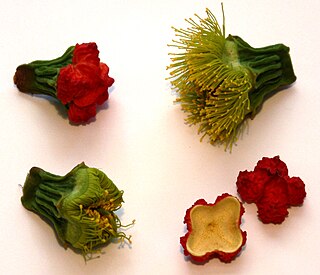
In botany, an operculum or calyptra is a cap-like structure in some flowering plants, mosses, and fungi. It is a covering, hood or lid, describing a feature in plant morphology.

Plantago ovata, known by many common names including blond plantain, desert Indianwheat, blond psyllium, and ispaghol, is native to the Mediterranean region and naturalized in central, eastern, and south Asia and North America.

Plantago maritima, the sea plantain, seaside plantain or goose tongue, is a species of flowering plant in the plantain family Plantaginaceae. It has a subcosmopolitan distribution in temperate and Arctic regions, native to most of Europe, northwest Africa, northern and central Asia, northern North America, and southern South America.

Plantago nivalis is a species of flowering plant in the family Plantaginaceae. It is found in the Sierra Nevada of Spain.
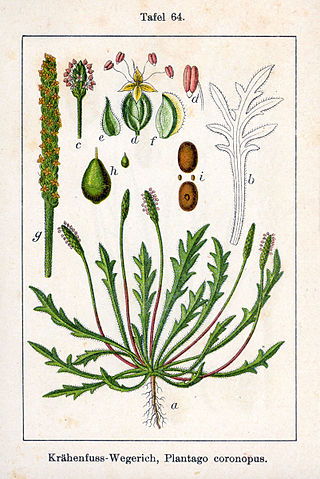
Plantago coronopus, the buck's-horn plantain, is a herbaceous annual to perennial flowering plant in the family Plantaginaceae. Other common names in the US and Italy include minutina and erba stella.

Plantago erecta is a flowering plant in the plantain family, commonly known as the California plantain, foothill plantain, dot-seed plantain, English plantain, and dwarf plantain. Plantago erecta is a small, unassuming annual herb with needle-like leaves and translucent flowers clustered on a stalk. It grows in sandy, clay, or serpentine soils, on grassy slopes and flats or open woodland, found in Baja California, California and Oregon. Plantago erecta is a host species for the Edith's checkerspot butterfly.

Plantago rugelii is an edible species of flowering plant in the plantain family, Plantaginaceae. It is native to North America, where it occurs in eastern Canada and the central and eastern United States. Its common names include American plantain, blackseed plantain, pale plantain, and Rugel's plantain. The species name rugelii honors Ferdinand Ignatius Xavier Rugel (1806-1879), a German-born botanist and pharmacist.

Plantago rhodosperma is a species of flowering plant in the plantain family known by the common names redseed plantain and redseed indianwheat. It is native to the Great Plains and Southwest of the United States.
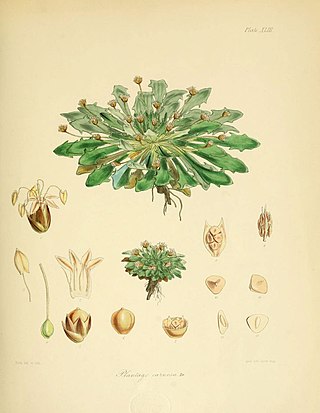
Plantago triantha is an annual plant of the family Plantaginaceae that is found in both Tasmania and the Auckland Islands.

Plantago indica, commonly known as branched plantain, sand plantain, or black psyllium, is a flowering plant in the plantain family Plantaginaceae, and is one of a few species in the Plantago genus under the common name psyllium. The plant is native to parts of Africa, Europe, Russia, and Asia, and has been naturalized in many other areas such as Australia and North America. The plant can be found mostly in dry inland areas, such as those that are sandy, and has also naturalized on roadsides and in meadows. The plant is not used broadly as a food source, but has been cultivated for its seeds which serve a medicinal use as a laxative.
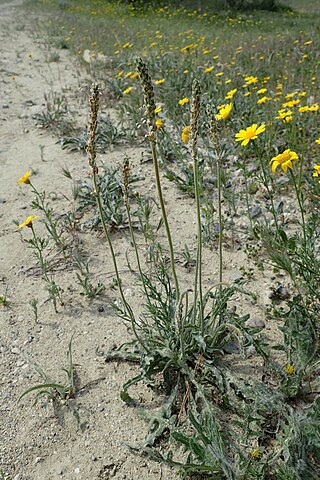
Plantago albicans is a species of perennial herb in the family Plantaginaceae. They have a self-supporting growth form, simple, broad leaves and dry fruit. Individuals can grow to 0.3 m.
Plantago bellardii is a species of annual herb in the family Plantaginaceae. They have a self-supporting growth form and simple, broad leaves. Individuals can grow to 4 cm tall.
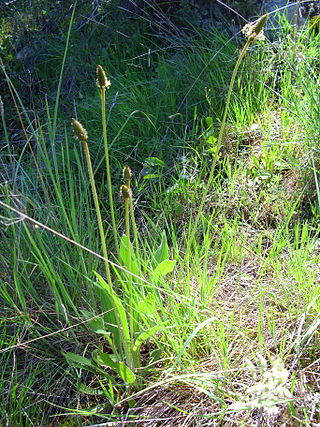
Plantago lagopus, the hare's foot plantain, is a species of annual herb in the family Plantaginaceae. They have a self-supporting growth form and simple, broad leaves. Flowers are visited by Heliotaurus ruficollis, Malachius, Metopoplax origani, and brown argus. Individuals can grow to 25 cm.

Plantago serraria is a species of plants in the family Plantaginaceae.



















